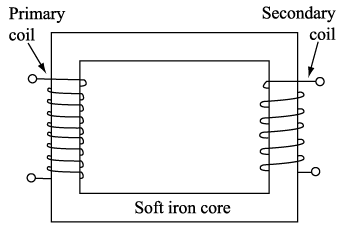
5"B" 08/12/08
We went through the electromagnetism test. Some of you did pretty well really.
I gave out AQA GCSE 2003 as more revision questions. Maybe model answers next time.
RM = No. You = revise radioactivity.
Test was sat on em. Then syllabi were handed out along with spec. paper 2H and 3.
We went through the test. Under 50%ers are doing another one on Friday. Syllabuses were handed out and we looked at the spec. paper 2H.
No test. Too many historical absentees. The test will happen first thing next lesson.
Electromagnetism test.
We discussed transformers and their use in the national grid.

They have 2 coils joined by an iron core. AC (alternating current) sent into the primary coil causes an alternating voltage to be induced in the secondary coil. This is due to the changing magnetic field putting a force on the electrons in the second coil.
The alternating voltage can be larger or smaller than the input voltage depending on whther there are more or less turns in the secondary coil than the primary one.
We looked at a little mock up of the power distribution system.

Power is generated by turning coils in magnetic fields. It is then stepped up to very high voltages to be sent long distances around the country.
In a nutshell, you must learn the following points:
N1/N2=V1/V2
We discussed transformers and their use in the national grid.

They have 2 coils joined by an iron core. AC (alternating current) sent into the primary coil causes an alternating voltage to be induced in the secondary coil. This is due to the changing magnetic field putting a force on the electrons in the second coil.
The alternating voltage can be larger or smaller than the input voltage depending on whther there are more or less turns in the secondary coil than the primary one.
We looked at a little mock up of the power distribution system.

Power is generated by turning coils in magnetic fields. It is then stepped up to very high voltages to be sent long distances around the country.
In a nutshell, you must learn the following points:
N1/N2=V1/V2
Showing the magnetic effect of an induced current opposing the change that causes it in the first place.
HW Revise for a test on all of electromagnetism. Use transformers 1 sheet to help you.
I showed you this very device....
Showing the magnetic effect of an induced current opposing the change that causes it in the first place.
We then moved on to doing some work on transformers from Physics Matters.
HW "Transformers 1" sheet to be finished by next time (if not done already) and finish Physics Matters P277 HW Qs
We built transformers and connected them to an alternating current power supply.

N1/N2=V1/V2
HW Transformer 1 question sheet.
We built transformers and connected them to an alternating current power supply.

N1/N2=V1/V2
HW Sheet on electromagnetic induction.
We looked some more at electromagnetic induction. A voltage can be induced in a conductor when it experiences a change in magnetic field. This can be achieved in 3 main ways:
I showed you a little demonstration device which used the latter. This was really a simple transformer.
You then did some work on electromagnetic induction from the Physics Matters book.
HW P275 Qs 1 + 2 from Physics Matters on generators.
No. RM = CCF. You did electromagnetic induction from the PTA book.
You wrote some notes this time on the other devices that use electromagnets, and we finished off the electromagnetic forces topic.
We looked at a loudspeaker, which uses electromagnetic forces to work.
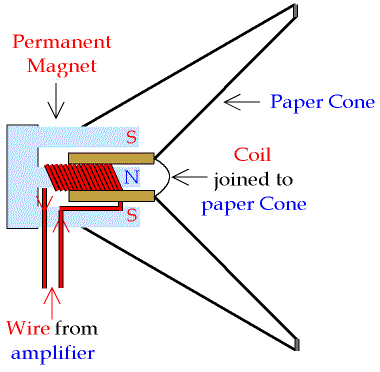
The loudspeaker uses a coil which can slide backwards and forwards over the central pole of a circular permanent magnet. Attached to the coil is the speaker cone.
Sending a current through the coil causes it to develop a magnetic field which means it feels a magnetic force of repulsion or attraction to the permanent magnet.
Sending an alternating current into the coil causes it to alternately be attracted and repelled, so it vibrates at the same frequency as the a.c. The speaker cone therefore generates a sound.
The other electromagnetic force devices you need to know about are:
1. Electromagnets (coils with soft iron cores)
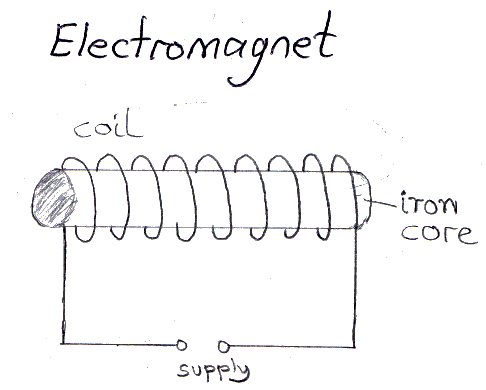
2. Relay switches (to magnetically move an iron switch in electronics)

3. Circuit breakers ("resetable fuses")

4. electric bells (bells which are electric)
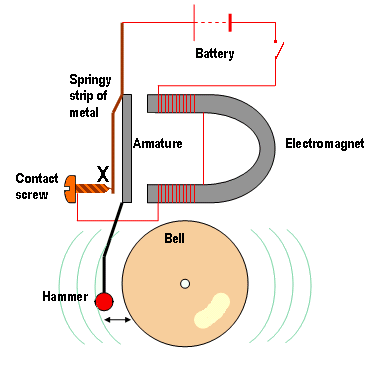
You recieved some nice notes on all that we've covered so far and we started electromagnetic induction.
We saw a demonstration of electromagnetic induction. We already know that moving charges experience a force in a magnetic field. If a conductor is physically moved through a magnetic field, the free charge carriers inside the conductor experience a force. This force pushes them through the conductor, it is an induced voltage. An induced voltage can cause an induced current if the conductor is connected as part of a complete circuit.
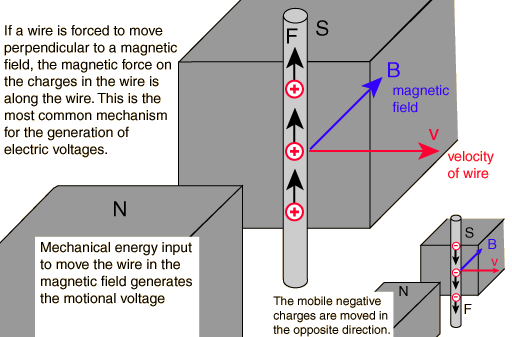
Both positive and negative charges within the wire feel a force (in opposite directions), but only the free electrons are able to move.
The induced voltage is reversed if the wire is moved the other way. The induced voltage is made stronger by moving the wire faster, or having a stronger magnetic field.
We saw a simple generator connected up to an oscilloscope.

A magnet was rotated quickly near to a coil of wire. The ends of the coil were attached to an oscilloscope which recorded the voltage across the coil and how it changed over time.
Any conductor that experiences a changing magnetic field will have a voltage induced in it (the electrons inside experience an electromagnetic force along the wire.

Several designs are possible. You can rotate the coil of wire, or you can rotate the magnet, as long as the wire is passing through magnetic field lines, a voltage will be produced.

A simple generator like the one we used wil create a alternating current(ac). The frequency of the ac depends on how often the magnet rotates. Rotating the magnet faster increases the number of peaks and troughs per seond in the induced voltage and increase the size of the induced voltage (as magnet is moving faster, putting larger electromagnetic force on the electrons within the coil.
HW Complete the questions on electromagnetic induction from your handout. Get caught up with any missing homework before your reports are finalised!
You wrote some notes this time on the other devices that use electromagnets, and we finished off the electromagnetic forces topic.
You recieved some nice notes on all that we've covered so far and we started electromagnetic induction.
We saw a demonstration of electromagnetic induction. We already know that moving charges experience a force in a magnetic field. If a conductor is physically moved through a magnetic field, the free charge carriers inside the conductor experience a force. This force pushes them through the conductor, it is an induced voltage. An induced voltage can cause an induced current if the conductor is connected as part of a complete circuit.

Both positive and negative charges within the wire feel a force (in opposite directions), but only the free electrons are able to move.
The induced voltage is reversed if the wire is moved the other way. The induced voltage is made stronger by moving the wire faster, or having a stronger magnetic field.
We saw a simple generator connected up to an oscilloscope.

A magnet was rotated quickly near to a coil of wire. The ends of the coil were attached to an oscilloscope which recorded the voltage across the coil and how it changed over time.
Any conductor that experiences a changing magnetic field will have a voltage induced in it (the electrons inside experience an electromagnetic force along the wire.

Several designs are possible. You can rotate the coil of wire, or you can rotate the magnet, as long as the wire is passing through magnetic field lines, a voltage will be produced.

A simple generator like the one we used wil create a alternating current(ac). The frequency of the ac depends on how often the magnet rotates. Rotating the magnet faster increases the number of peaks and troughs per seond in the induced voltage and increase the size of the induced voltage (as magnet is moving faster, putting larger electromagnetic force on the elctrons within the coil.
HW Questions on electromagnetic forces (not the one about motors, you should have already done that, but all the others.) You need to catch up on any other HW you have missing before next Monday or I'll write horrible things about you in your report.
We looked at the adaptations made which improve the performance of commercial electric motors. Curved pole pieces, many turns, several seperate coils, powerful electromagnets rather than permanent magnets and using carbon brushes were all mentioned.
We did some questions using Fleming's left hand law.

HW Finish the set of questions on motors.
We did some questions using Fleming's left hand law.

You lot nearly dislocated your wrists at times.
We moved on to some uses of electromagnetism.
We then looked at a loudspeaker, which uses electromagnetic forces to work.

The loudspeaker uses a coil which can slide backwards and forwards over the central pole of a circular permanent magnet. Attached to the coil is the speaker cone.
Sending a current through the coil causes it to develop a magnetic field which means it feels a magnetic force of repulsion or attraction to the permanent magnet.
Sending an alternating current into the coil causes it to alternately be attracted and repelled, so it vibrates at the same frequency as the a.c. The speaker cone therefore generates a sound.
The other electromagnetic force devices you need to know about are:
1. Electromagnets (coils with soft iron cores)

2. Relay switches (to magnetically move an iron switch in electronics)

3. Circuit breakers ("resetable fuses")

4. electric bells (bells which are electric)

But we didn't make notes.....
HW Finish my set of Qs on motors. Hand your book in on Monday with P176 Q2 if not already done.
We will have tried to build electric motors from scatch.
The magnetic force on a current carrying wire running perpendicular to a magnetic field is at right angles to the field and the wire. The magnetic force is reversed if the current direction is reversed. Hence, a loop of wire experiences a twisting force in an extrenal magnetic field.
They are difficult to manufacture because of the problem of providing an electrical connection to the coil which both allows turning and also reverses the current every half turn so the coil wil continue to spin.
Paul and Max D were the winners with the first spinner and the best spinner. 100% (ish) success rate is very good indeed.

Here is an animation which attempts to portray what is happening.


To keep the turning force on a DC motor from reversing every time the coil moves through the plane perpendicular to the magnetic field, a split-ring device called a commutator is used to reverse the current at that point. The electrical contacts to the rotating ring are called "brushes" since copper brush contacts were used in early motors. Modern motors normally use spring-loaded carbon contacts, but the historical name for the contacts has persisted.
Motors can be made to turn faster by increasing the external magnetic field, having more turns in your loop of wire or by having more current flowing through the loop.
If you reverse the direction of the current by switching your power supply around, the motor can rotate in the oppostie direction.
Look here for more explanation on how a dc motor works.
HW Yes. 1 double sided sheet of Qs on motors then make sure Q2 P176 is complete in your book for next time.
We will have tried to build electric motors from scatch.
The magnetic force on a current carrying wire running perpendicular to a magnetic field is at right angles to the field and the wire. The magnetic force is reversed if the current direction is reversed. Hence, a loop of wire experiences a twisting force in an extrenal magnetic field.
They are difficult to manufacture because of the problem of providing an electrical connection to the coil which both allows turning and also reverses the current every half turn so the coil wil continue to spin.
Paul and Max D were the winners with the first spinner and the best spinner. 75% success rate is very good indeed.

Here is an animation which attempts to portray what is happening.


To keep the turning force on a DC motor from reversing every time the coil moves through the plane perpendicular to the magnetic field, a split-ring device called a commutator is used to reverse the current at that point. The electrical contacts to the rotating ring are called "brushes" since copper brush contacts were used in early motors. Modern motors normally use spring-loaded carbon contacts, but the historical name for the contacts has persisted.
Motors can be made to turn faster by increasing the external magnetic field, having more turns in your loop of wire or by having more current flowing through the loop.
If you reverse the direction of the current by switching your power supply around, the motor can rotate in the oppostie direction.
HW Yes. 1 double sided sheet of Qs on motors then make sure Q2 P176 is complete in your book for next time.
We saw some demonstration electric motors.
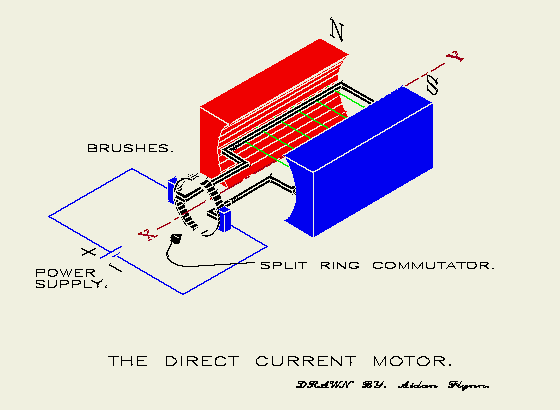
Particular attention was paid to the role of the split ring commutator, providing a sliding contact that reverses the current in the coil every half turn.
HW Q2 P176 of IGCSE Physics.
Strength of an electromagnet experiment.
We tested the effect of varying the current and the number of turns in the electromagnet.
More turns meant a stronger magnet.
More current meant a stronger magnet.
No iron core meant a totally rubbish magnet.
HW Complete your conclusion in your book then complete the 2 short questions on electromagnets.
Not sure. That's right. I showed you that a bar magnet can be used to deflect a beam of electrons. Moving electrons don't have to be inside a wire in order to experience a magnetic force.
Check out what magnets can do to old fashioned TVs, which use electron beams.
We then started to look at how electric motors work. They employ the same motor effect as in the "kicking wire" to make a coil of wire twist. More on this next week.
No. You did PM cover work on electromagnets.
Strength of an electromagnet experiment.
Magnetic fields around a current carrying wire and a solenoid.

The direction of the force can be determined by Fleming's left hand law.

The physical reason for this force is due to the combining of the magnetic field from the the wire and the external magnets. The fields agree on one side of the wire, but cancel each other out on the other. This is known as the catapult field effect.

A force is always felt from areas of strong magnetic field to areas of weak magnetic field. Strong fields are shown by the field lines being closer together.
The direction of the force will be reversed if either the current is reversed or the magnetic field is reversed (but not both). The force is made stronger by increasing the current (more moving charge to experience a force) or making the external magnetic field stronger.
HW P167 Qs 1+2
Magnetic fields around a current carrying wire and a solenoid.

The direction of the force can be determined by Fleming's left hand law.

The physical reason for this force is due to the combining of the magnetic field from the the wire and the external magnets. The fields agree on one side of the wire, but cancel each other out on the other. This is known as the catapult field effect.

A force is always felt from areas of strong magnetic field to areas of weak magnetic field. Strong fields are shown by the field lines being closer together.
The direction of the force will be reversed if either the current is reversed or the magnetic field is reversed (but not both). The force is made stronger by increasing the current (more moving charge to experience a force) or making the external magnetic field stronger.
Magnetic fields around a current carrying wire and a solenoid.
We went through the test. There is a compulsory resit for everybody who got 50% or below, or for anyone who wants a rather better grade this half term. It is in my room at the start of Thursday lunchtime.
We started the new topic - electromagnetism.
We started electromagnetic forces by recapping simple magnetism.
Important points:

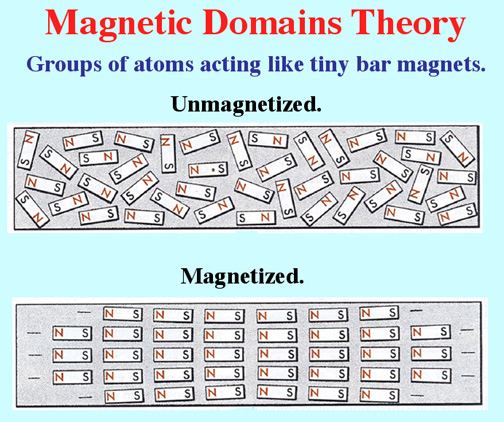
We did a little "kicking wire" demo.
A bit like that above. You became aware that a current carrying wire experiences a force in a magnetic field, which is at right angles to the wire and the magnetic field. If the current direction was reversed, so was the force direction. If the magnets were swapped over, the force directio was also reversed.
HW Complete the little handout on your kicking wire demo.
We went through the test. There is a compulsory resit for everybody who got 50% or below, or for anyone who wants a rather better grade this half term. It is in my room at the start of Thursday lunchtime.
We started the new topic - electromagnetism.
We started electromagnetic forces by recapping simple magnetism.
Important points:


We did a little "kicking wire" demo.
A bit like that above. You became aware that a current carrying wire experiences a force in a magnetic field, which is at right angles to the wire and the magnetic field. If the current direction was reversed, so was the force direction. If the magnets were swapped over, the force directio was also reversed.
HW Complete the little handout on your kicking wire demo.
Test.
The promised test appeared.
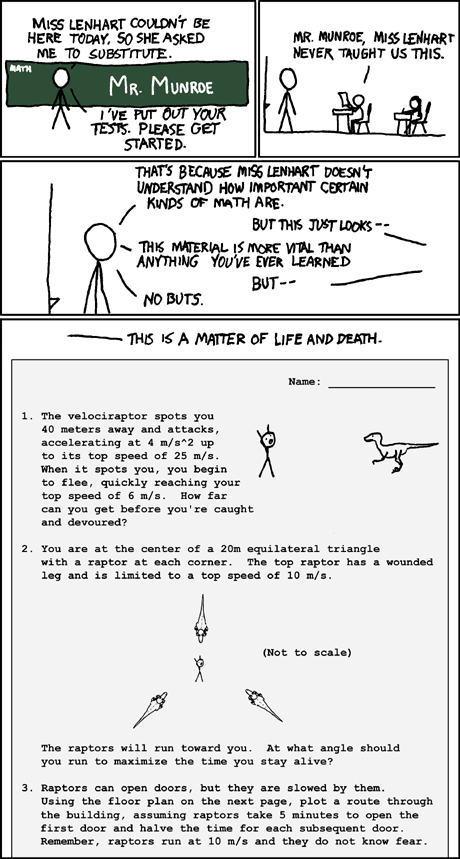
Remember that if you can't be bothered to check the website, I basically hate you. So you'll find very little sympathy - it's here for you to check up when you're away!
1/3 absent (Rosh holiday). The remainder of us did some more preparation for an energy test that will be sat on Monday. You looked at the syllabus for this section, it tells you all you need to know.
HW Including those absent from today! Revise for a test on:
Energy transfers and efficiency.
Work, energy and power calculations.
Thermal energy transfer.
Energy resources.
We wil be revising merrily away ont the energy topic, despite some people missing for holidays.
Lots of Qs will have been completed, there will be a test next lesson. If you missed this lesson then you will be glad that you checked the website to catch up.
HW revise for a test on:
Energy transfers and efficiency.
Work, energy and power calculations.
Thermal energy transfer.
Energy resources.
We did some more revision on energy. There will be a test next Monday covering:
Energy transfers and efficiency.
Work, energy and power calculations.
Thermal energy transfer.
Energy resources.
HW Essays came in from most - get them in asap if not today.
You are going to do an essay type task for me on energy resources. We watched a video on nuclear fusion in preparation for this.
More information can be found here. Or just google "ITER".
HW A 500 word essay summarising the current energy resources available to mankind and the advantages and disadvantages of each. Then conculde with what youthink the best way forward might be in the next 50 to 100 years.
We completed a whole bunch of questions on energy resources (very geography really) which may well help you to think about your essay which is due in next time.
As far as exam questions go, it is just remembering a couple of advantages and disadvantages of each resource really.
Look up facts and figures to help you on the internet.
HW Still doing that essay which is due in for Monday.
We finished off the thermal energy transfer topic by looking at ways of avoiding convection. Cavity wall insulation, draughts excluders being a couple od household ones.
NB: In convection - particles spread out and make the fluid as a whole less dense. There is no change to the density of the individual particles.
We also looked at the way a vacuum flask avoids all 3 methods of heat transfer.
We finished the video detailing Earth's energy resources. You must be able to make decent points about the difference between renewable and non-renewable resources and economic and enviromental issues surrounding them.
HW Qs 3,4,5 P140 (perhaps on paper, as I have most books in.)
We finished the video detailing Earth's energy resources. You must be able to make decent points about the difference between renewable and non-renewable resources and economic and enviromental issues surrounding them.
Don't forget that mankind is totally doomed without the development of nuclear fusion power in the next 100 years or so, so get on it - you're suppposed to be clever. Read this and go and work there.
HW Due in next Monday - write a 500 word summary of the energy resources available on Earth and conclude what you think the best way to ensure a continual suppply of energy for the growing global population is.
We saw some videos on conduction, convection and radiation. We still need to do a smidge on insulation. Then onto energy resources.
HW P142 Q 4 and 6
We were once again cruelly interrupted by assembly. However, we finished off the thermal energy transfer topic by looking at ways of avoiding convection. Cavity wall insulation, draughts excluders being a couple od household ones.
We also looked at the way a vacuum flask avoids all 3 methods of heat transfer.
You HW due in today was extended to be due in next time only with the whole sheet completed.
We then started to look at energy resources and electricity generation as a new topic. We got 2/3 of the way through a video summarising the predicament the world currently finds itself in.
HW Finish entire set of GCSE thermal questions as above.
Conduction, convection and radiation.

We saw 2 demonstrations of convection:
2 - a mock up of a mine with 2 vertical shafts and a candle lit under one of them (this allowed fresh air to be drawn into mines).
3 - a hot air balloon.

Sea breezes, which occur because the sea has a large heat capacity than the land.

At night, the opposite happens..

HW Do the first 2 questions from you set on thermal energy transfer only.
You guys were extremely late after assembly. We put down some notes on insulation (basically avoiding thermal energy transfer) for conduction and radiation. Convection must be finished off next lesson.
HW Do the first 2 sides only of the set of thermal energy transfer GCSE questions I gave you. Books should have come in with Q 3 and 7 P122.
Barring mishap, you will have attempted some GCSE/iGCSE questions on work, energy and power to ensure you are doing OK on that topic. We'll move on to thermal energy transfer next time.
HW Almost certainly to finish off the set of questions stated in the lesson to hand in next time. Yep, that's right.
Conduction, convection and radiation.

We saw 2 demonstrations of convection:
2 - a mock up of a mine with 2 vertical shafts and a candle lit under one of them (this allowed fresh air to be drawn into mines).
3 - a hot air balloon.

Sea breezes, which occur because the sea has a large heat capacity than the land.

At night, the opposite happens..

HW Complete your notes on conduction, convection and radiation. Also attempt Qs 3 + 7 P122 from the IGCSE book.
Better effort with text books today.
More on work, energy and power.
A falling object transfers GPE to KE. If friction can be ignored, then all of the GPE will go to KE. You can use this effect to calculate how fast something will be moving after it has fallen a certain distance.
GPE = mgh
KE = 1/2mv2
mgh = 1/2mv2
The mass makes no difference to how fast it will end up falling as it can be cancelled out from both sides of the equation (something we already know from the forces and motion topic)
gh = 1/2v2
2gh = v2
So v is the square root of 2gh where g is the Earth's gravitational field strength and h is the height an object has dropped through.
We also covered power, the rate of energy transfer.
We re-capped efficiency from last year, not too taxing a concept.
Efficiency is the proportion of the total energy put into a system or machine, which is converted into the desired type. It is usually expressed as a percentage.
Effiency = Useful energy out / Total energy in * 100%
The sort of machine or process being used determines what the useful type of energy is.
HW Finish P113 Q 3 + 4, then do P141 Q 2 + 3 in exercise books for next time.
Better effort with text books today.
We re-capped efficiency from last year, not too taxing a concept.
Efficiency is the proportion of the total energy put into a system or machine, which is converted into the desired type. It is usually expressed as a percentage.
Effiency = Useful energy out / Total energy in * 100%
The sort of machine or process being used determines what the useful type of energy is.
HW P141 Q2 parts a and b only.
New exercise books were issued, along with new folders for handouts etc.
This website will stlll operate for now, although it may be taken over by the school one in the nearish future.
We have covered 2/3 of the course already, we have energy to finish, electromagnetism and gas laws to do.
We used the first lesson to recap the energy formulae that we covered at the end of the Summer. You must be able to use the formulae for kinetic energy, gravitational potential energy, work done and power. We recapped
GPE = mgh
KE = 1/2mv2
We'll continue with this on Tuesday.
This is all covered by chapter 15 of the text book. Make sure that you have you own copy (and not someone else's) by next lesson please. �11.99 cheque made payable to the school for all of you who have lost them.
Welcome back to Physics!
New exercise books were issued, along with new folders for handouts etc.
This website will stlll operate for now, although it may be taken over by the school one in the nearish future.
We have covered 2/3 of the course already, we have energy to finish, electromagnetism and gas laws to do.
We used the first lesson to recap the energy formulae that we covered at the end of the Summer. You must be able to use the formulae for kinetic energy, gravitational potential energy, work done and power.
This is all covered by chapter 15 of the text book. Make sure that you have you own copy (and not someone else's) by next lesson please.
HW Finish P130 Qs 1-9 in your nice new exercise book for hand in next time (Monday morning). Below may help with Q6.
A falling object transfers GPE to KE. If friction can be ignored, then all of the GPE will go to KE. You can use this effect to calculate how fast something will be moving after it has fallen a certain distance.
GPE = mgh
KE = 1/2mv2
mgh = 1/2mv2
The mass makes no difference to how fast it will end up falling as it can be cancelled out from both sides of the equation (something we already know from the forces and motion topic)
gh = 1/2v2
2gh = v2
So v is the square root of 2gh where g is the Earth's gravitational field strength and h is the height an object has dropped through.